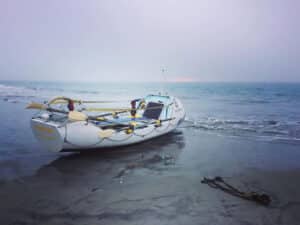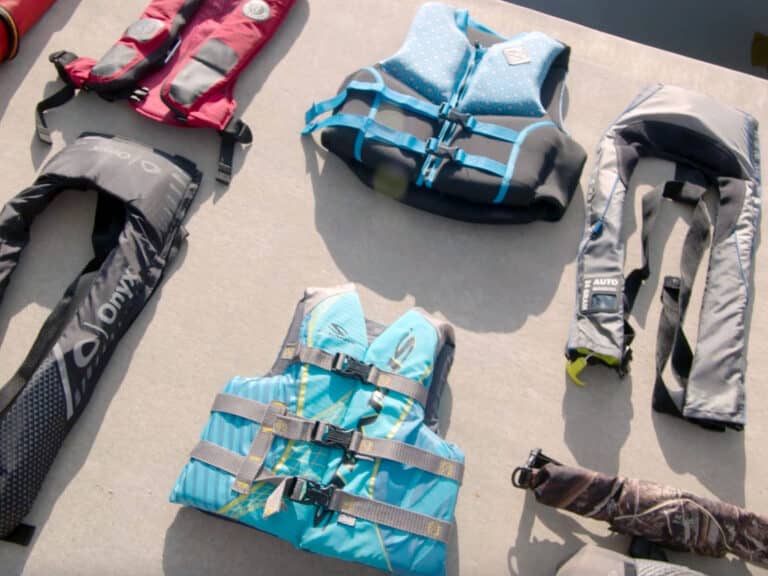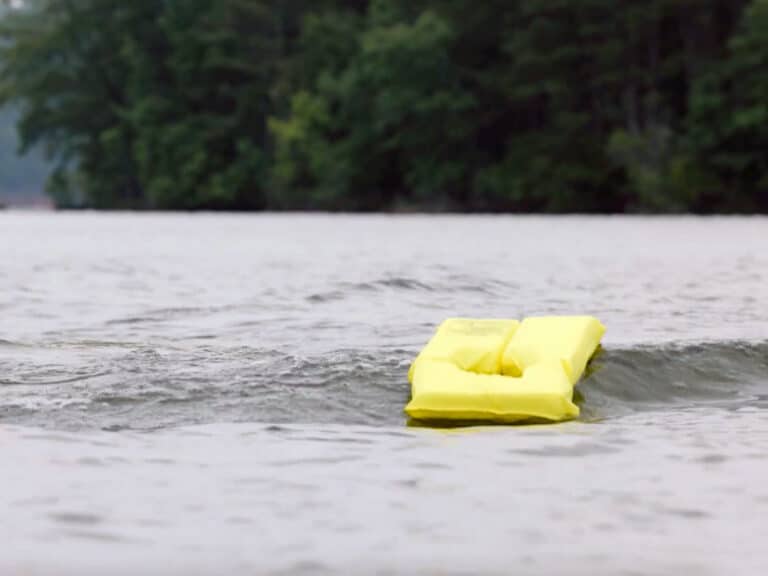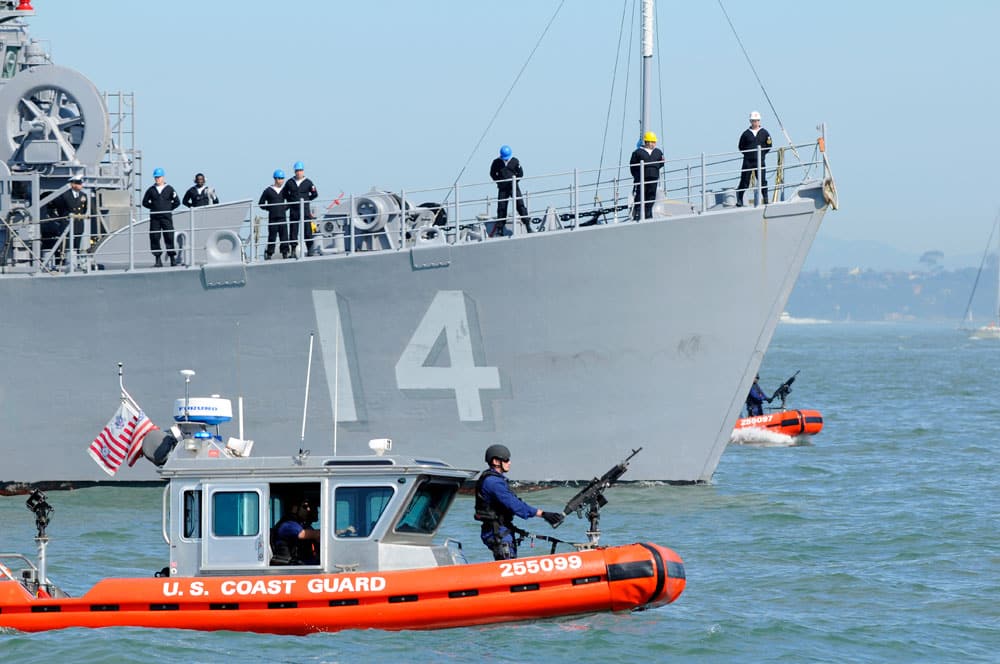
In the aftermath of the September 11, 2001 terrorist attacks on the World Trade Center and the Pentagon, the U.S. Coast Guard took on an expanded homeland security mission in addition to its traditional roles of enforcing maritime law, conducting lifesaving search and rescue operations, promoting recreational boating safety, conducting counter-narcotics operations, preventing damage to the marine environment and helping to enforce immigration law.
Staying alert to potential waterborne terrorist activity and securing more than 95,000 miles of shoreline and 290,000 square miles of water is a huge undertaking. An attack on a major port or any critical maritime infrastructure could have devastating consequences, causing widespread loss of life and sending ripple effects throughout the U.S. population and economy.
Coast Guard personnel are the Nation’s first federal responders in a maritime emergency. Those who boat or live or work on or near the water can help the Coast Guard by participating in America’s Waterway Watch (AWW) and reporting any observed suspicious activity, as well as by obeying the new rules put in place to safeguard military and commercial shipping and critical infrastructure.
Watch for Suspicious Activity….
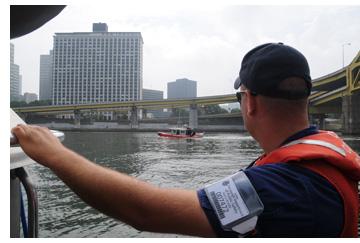
Average citizens can and do play an important role in national security. If you are one of America’s approximately 82 million recreational boaters, or if you live, work, or engage in recreational activities on or near the nation’s waterways, you can help keep these areas safe by participating in America’s Waterway Watch and reporting suspicious activities to local law enforcement agencies.
The U.S. Coast Guard’s AWW program is based on the same principles as Neighborhood Watch and enlists the efforts of the Coast Guard, its Reserve and Auxiliary components, the United States Power Squadrons, and local residents, boaters and businesses, to augment security.
Always remember that people are not suspicious, behavior is. Call 877-24WATCH (877-249-2824) if you notice any of the following:
- Someone taking pictures, video or making sketches of facilities, such as bridges, tunnels, ferry transport systems, fuel docks or power plants.
- Someone asking questions about access to one of these facilities.
- Someone anchoring, fishing or diving in an area not typically used for that activity.
- Unusual night operations, including lights flashing between boats.
- Any boater who misuses their vessel or seems strangely unfamiliar with its operation.
- Unattended vessels near bridges or in unusual locations.
- Unusual transfer of personnel or cargo while underway, anyone tossing items into waterways or onto shorelines, or anyone recovering such items.
- Anyone trying to access a boat by force.
- Seeing a hole in a security fence around an industrial facility.
Do not take matters into your own hands. Call 877-24WATCH (877-249-2824). If you believe there is immediate danger to life or property, call the Coast Guard on Channel 16 VHF-FM, or dial 911. As the Department of Homeland Security puts it: If you see something, say something.
To learn more, visit the America’s Waterway Watch website at www.americaswaterwaywatch.org.
….And Make Sure You Know the New Rules
The Coast Guard has increased waterway security and established Safety and Security Zones to prevent attacks on U.S. Naval vessels, cruise ships and commercial vessels, as well as on critical infrastructure, such as petroleum facilities and nuclear power plants situated on or near the water. As a recreational boater, not knowing how to act in certain areas or situations may put you in legal jeopardy or, worse, at risk of personal injury. These are serious times requiring serious measures, so help protect our country by learning the new rules:
Naval Vessel Protection Zones
To prevent attacks on our Navy, such as that on the USS Cole in October 2000, the federal government has established Naval Vessel Protection Zones that limit how closely you may come to a naval vessel. By this rule, you may not approach closer than 100 yards, and must slow to minimum speed within 500 yards of any U.S. Naval vessel. If you need to approach within 100 yards in order to ensure a safe passage in accordance with the Navigation Rules, you must contact the naval vessel or the U.S. Coast Guard escort vessel on your VHF radio (Channel 16) for authorization.
If a naval vessel is passing near where you are operating your boat, you may be asked to move your vessel to maintain the 100-yard distance. The U.S. Coast Guard will make an announcement ahead of time to alert boaters in the area via the “Broadcast Notice to Mariners” on VHF Channel 16 and 22, and the “Local Notice to Mariners,” available at www.navcen.uscg.gov/?pageName=InmMain under “Current Operational/Safety Information.
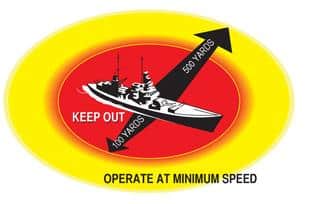
Serious times require serious measures. Be aware that a violation of a Naval Vessel Protection Zone is a felony offense, punishable by up to six years in prison and/or up to a $250,000 fine, and both the U.S. Navy and the U.S. Coast Guard are authorized to use deadly force. For your safety and the safety of our naval vessels, learn and abide by the new rules.
Commercial Shipping Safety Zones
In addition to the Naval Vessel Protection Zone requirements, boaters may also be asked to avoid operating near certain commercial vessels, cruise liners and commercial facilities near the water. Boaters need to observe and respect these safety zones. Areas that have large marine facilities – including military, commercial/cruise or petroleum facilities – should be avoided. Note that there are also restrictions near most dams and power plants.
Depending on what is being safeguarded and current threat levels, zones may be fixed or moving, temporary or permanent. While some waterfront facilities may have signs warning boaters not to approach, anchor, loiter, etc., be aware that most do not. Look for Safety Zones marked on nautical charts with a solid magenta line around the designated zone and an explanation in the chart notes. Boaters can also locate these zones by consulting the United States Coast Pilot reference book (available online at nauticalcharts.noaa.gov/publications/coast-pilot) for the area in which they are operating.
Again, the Coast Guard provides boaters with advance notice of zone enforcement via the “Broadcast Notice to Mariners” on VHF Channel 16 and 22, as well as the “Local Notice to Mariners,” available at www.navcen.uscg.gov/?pageName=lnmMain. Announcements are made if the zone has been changed in some way or if temporary zone enforcement is necessary in response to activities that draw a lot of boaters on the water, such as festivals, air shows, fireworks events and others. Zone enforcement is also announced on the Federal Register, GovPulse.us, FedThread.org and many other online government sites.
Bridges and Shipping Channels
Do not stop or anchor beneath bridges or in shipping channels. If you do, you can expect to be asked to move and/or be boarded by law enforcement officials.
The U.S. Coast Guard is asking all boat owners and operators to help reduce fatalities, injuries, property damage, and associated healthcare costs related to recreational boating accidents by taking personal responsibility for their own safety and the safety of their passengers. Essential steps include: wearing a life jacket at all times and requiring passengers to do the same; never boating under the influence (BUI); successfully completing a boating safety course; and getting a Vessel Safety Check (VSC) annually from local U.S. Coast Guard Auxiliary, United States Power Squadrons(r), or your state boating agency’s Vessel Examiners. The U.S. Coast Guard reminds all boaters to “Boat Responsibly!” For more tips on boating safety, visit www.uscgboating.org.



